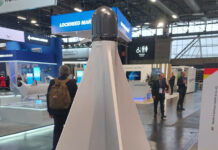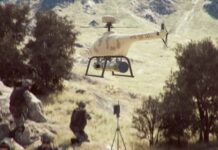 While the manned combat vehicle of the FCS family of weapons has yet to debut publicly, substantial progress has been made already, with FCS family of vehicles with the first platform – then Non-Line-Of-Sight-Cannon (NLOS-C) scheduled to roll off the production line this year. (see the recent GAO report about FCS in this issue). Another platform making progress is the XM-1202 Maneuver Combat System (MCS) – the light ‘tank’ of the FCS unit. MCS will have a crew of three – a commander, driver (common crew) and a gunner. The vehicle will carry a remotely controlled turret mounting a lightweight, low-recoil 120mm cannon, firing standard (line of sight) and beyond line of sight mid-range-munition (MRM) type ammunition. Based on situational awareness, utilizing on-board and networked sensors, the MCS will dramatically improve first round lethality. Similar to other FCS vehicles, both MCS and NLOS-C will base its survivability on a multi-level concept, based on the classical ‘onion’ protection, utilizing stealth by signature management and maneuverability. Hit avoidance is provided by passive and active protection, armor protection by modular armor and mine protection. Kill avoidance will be maintained by design for survivability and redundancy, retaining partial operational capability and mobility after being hit. For a full coverage on the FCS program see “FCS on the Move” and a summary of the recent GAO report about the program.
While the manned combat vehicle of the FCS family of weapons has yet to debut publicly, substantial progress has been made already, with FCS family of vehicles with the first platform – then Non-Line-Of-Sight-Cannon (NLOS-C) scheduled to roll off the production line this year. (see the recent GAO report about FCS in this issue). Another platform making progress is the XM-1202 Maneuver Combat System (MCS) – the light ‘tank’ of the FCS unit. MCS will have a crew of three – a commander, driver (common crew) and a gunner. The vehicle will carry a remotely controlled turret mounting a lightweight, low-recoil 120mm cannon, firing standard (line of sight) and beyond line of sight mid-range-munition (MRM) type ammunition. Based on situational awareness, utilizing on-board and networked sensors, the MCS will dramatically improve first round lethality. Similar to other FCS vehicles, both MCS and NLOS-C will base its survivability on a multi-level concept, based on the classical ‘onion’ protection, utilizing stealth by signature management and maneuverability. Hit avoidance is provided by passive and active protection, armor protection by modular armor and mine protection. Kill avoidance will be maintained by design for survivability and redundancy, retaining partial operational capability and mobility after being hit. For a full coverage on the FCS program see “FCS on the Move” and a summary of the recent GAO report about the program.

At least some of the contenders for the joint light tactical vehicle (JLTV) and other platforms are eliminating the “deep V hull” design, favoring more useful and less restrictive “shallow V” or oblique floor, applied with floating floor, blast mitigating carpet and other protection features contributing to crew safety and survivability, without substantially increasing the vehicle’s height. JLTV program, several contenders demonstrated systems, BAE Systems + Navistar displayed their solution. Floor & belly covered by panels to protect from “prowling” competitors; Oshkosh and Northrop Grumman was even more paranoid, and kept their JLTV contender segregated under wraps, unveiled only to special access VIPs. Textron unveiled their Hercules, also dubbed “ASV on Steroids”. It is designed to assume some of the roles and missions currently carried out by the Armored Security Vehicle (ASV), while offering much improved protection. The vehicle will use advanced protection, significantly increasing survivability while maintaining performance and mobility similar to the ASV, excluding air transport in the C-130. For a full coverage of the JLTV program see: “JLTV in Motion” in this month’s issue and “JLTV Pathfinders“, covering JLTV technology demonstrators.

Having delivered five vehicles in response to an Army Operational Needs Statement, DRS Sustainment Systems is gearing up to begin production of the M1200 Armored Knight. The system uses an electro-optical multi-sensor target acquisition payload mounted and integrated on an M1117 Armored Security Vehicle to form the Reconnaissance, Surveillance and Target Acquisition (RSTA) platform. The original manufacturer of the ASV, Textron Marine & Land Systems, is also offering their version for the RSTA mission. The vehicle is fitted with a turret, mounting two automatic weapons (50 Cal and M19 grenade launcher) and mast-mounted Star SAFIRE IV EO payload made by FLIR Systems, comprising a 640×480 InSb focal plan array flir, a color CCD-TV, low-light level CCD camera and laser rangefinder, illuminator, designator and pointer. The system also comprises a digital IMU/GPS to facilitate quick geo-pointing and geo-location of targets.
 Unsolicited development by BAE Systems (RG33) and Oshkosh (HEMTT PLSR) were addressing the urgent need for heavy recovery vehicles in Iraq and Afghanistan, in support of heavy armored vehicles which are operating intensively and subjected to frequent attacks. Current recovery assets are sometime helpless when called to recover a disabled forty-ton MRAP, leaving the job for the M-88 Hercules, originally designed to support the heavy armor. Hercules has provided unmatched capabilities during Operation Iraqi Freedom. To date 210 Hercules vehicles have been fielded against a total U.S. Army requirement of 595 vehicles. A total of 68 have been fielded to the U.S. Marine Corps, which has decided on the single M88A2 configuration.The new heavy recovery vehicle is based on the RG-33 MRAP platform, equipped with a crane, winch and lifting bars. The hydraulic, telescopic crane can lift up to 40 ton, the towing drum is capable of horizontally towing the same weight while the telescopic lifting arms are capable of lifting up to 25 tons. This arm is designed for insertion under a disabled vehicle, lifting it by supporting the front or rear axle. A full coverage of MRAP and other heavy armored vehicles is available in our recent title “Beyond MRAP“.
Unsolicited development by BAE Systems (RG33) and Oshkosh (HEMTT PLSR) were addressing the urgent need for heavy recovery vehicles in Iraq and Afghanistan, in support of heavy armored vehicles which are operating intensively and subjected to frequent attacks. Current recovery assets are sometime helpless when called to recover a disabled forty-ton MRAP, leaving the job for the M-88 Hercules, originally designed to support the heavy armor. Hercules has provided unmatched capabilities during Operation Iraqi Freedom. To date 210 Hercules vehicles have been fielded against a total U.S. Army requirement of 595 vehicles. A total of 68 have been fielded to the U.S. Marine Corps, which has decided on the single M88A2 configuration.The new heavy recovery vehicle is based on the RG-33 MRAP platform, equipped with a crane, winch and lifting bars. The hydraulic, telescopic crane can lift up to 40 ton, the towing drum is capable of horizontally towing the same weight while the telescopic lifting arms are capable of lifting up to 25 tons. This arm is designed for insertion under a disabled vehicle, lifting it by supporting the front or rear axle. A full coverage of MRAP and other heavy armored vehicles is available in our recent title “Beyond MRAP“.

The Palletized Load System (PLS) is the backbone of the U.S. Army’s distribution and resupply missions. The newest member in this family, PLS Recovery vehicle will be able to rapidly and safely support disabled or damaged armored vehicles in a tactical environment. Some of the PLS/R assets are standard with the PLS (like the lifting crane) while others, such as the Tru-Hitch system, are already in the U.S. Army’s inventory. The 10×10 (five axles) PLS/R will be powered by a Detroit Diesel Model 8V92TA engine and have full-time all wheel drive. It will be equipped for and have the payload and power capacity to recover heavy armored vehicles such as MRAP or Stryker vehicles and, as such, will be instrumental in providing rapid recovery services where self-recovery and like-vehicle recovery is not feasible. The PLS/R will make it possible to overturn vehicles for recovery, perform slope recovery and recover vehicles mired in water, mud, sand and snow. Lift and tow operations are performed by a fifth wheel towing recovery device coupled to a Rotzler TR-80 winch. This device can also be engaged into a high mobility recovery trailer for evacuation of completely immobilized vehicles. The PLS/R also includes winching spade caps to provide a stable platform for heavy-duty winch recovery. Damage is reduced on vehicles’ axles and chassis due to the ability to perform flat towing.
 Another recovery vehicle unveiled here was the maintenance and recovery vehicle (MRV) version of the Stryker, fitted with a winch, pulling more than 40,000 lbf, crane capable of lifting 16.5 tons and an hydraulically operated earth anchor made of ballistic steel, which also adds to frontal protection. The vehicle is designed to support Stryker combat brigade teams, performing recovery operations, lifting, and Stryker vehicle fleet support wherever the brigade deploy.
Another recovery vehicle unveiled here was the maintenance and recovery vehicle (MRV) version of the Stryker, fitted with a winch, pulling more than 40,000 lbf, crane capable of lifting 16.5 tons and an hydraulically operated earth anchor made of ballistic steel, which also adds to frontal protection. The vehicle is designed to support Stryker combat brigade teams, performing recovery operations, lifting, and Stryker vehicle fleet support wherever the brigade deploy.
For more reading on combat vehilce recovery, see our previous item on new recovery systems for the USMC.
Additional articles in this review:



















